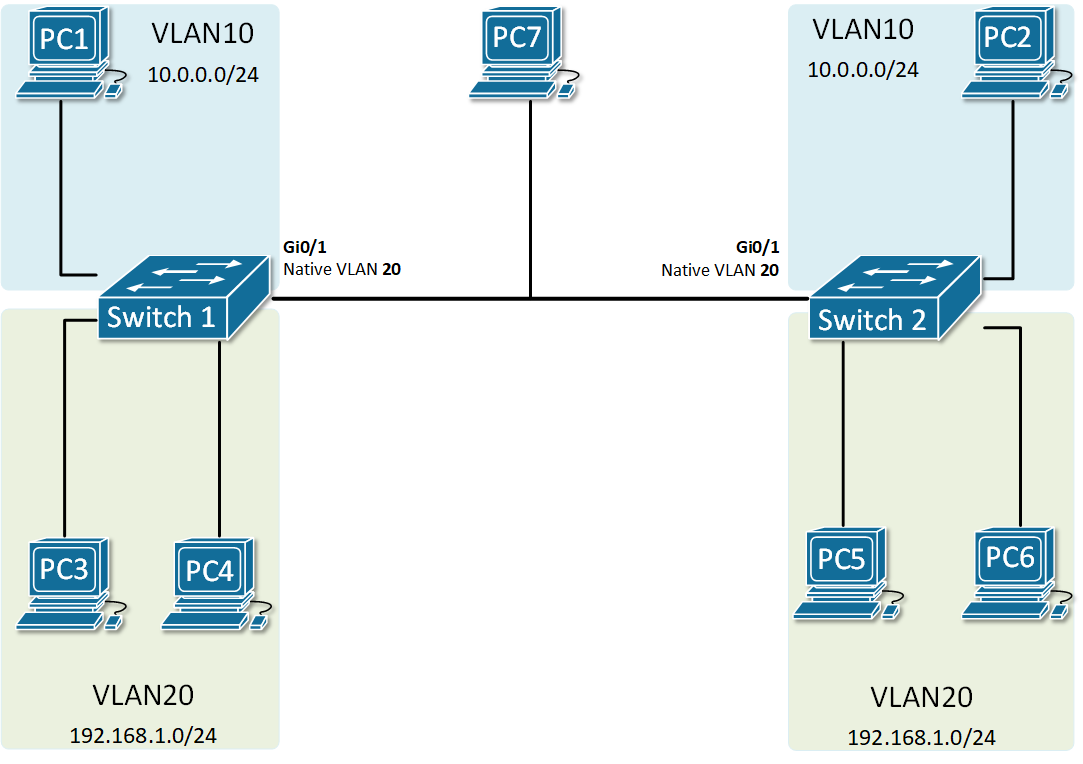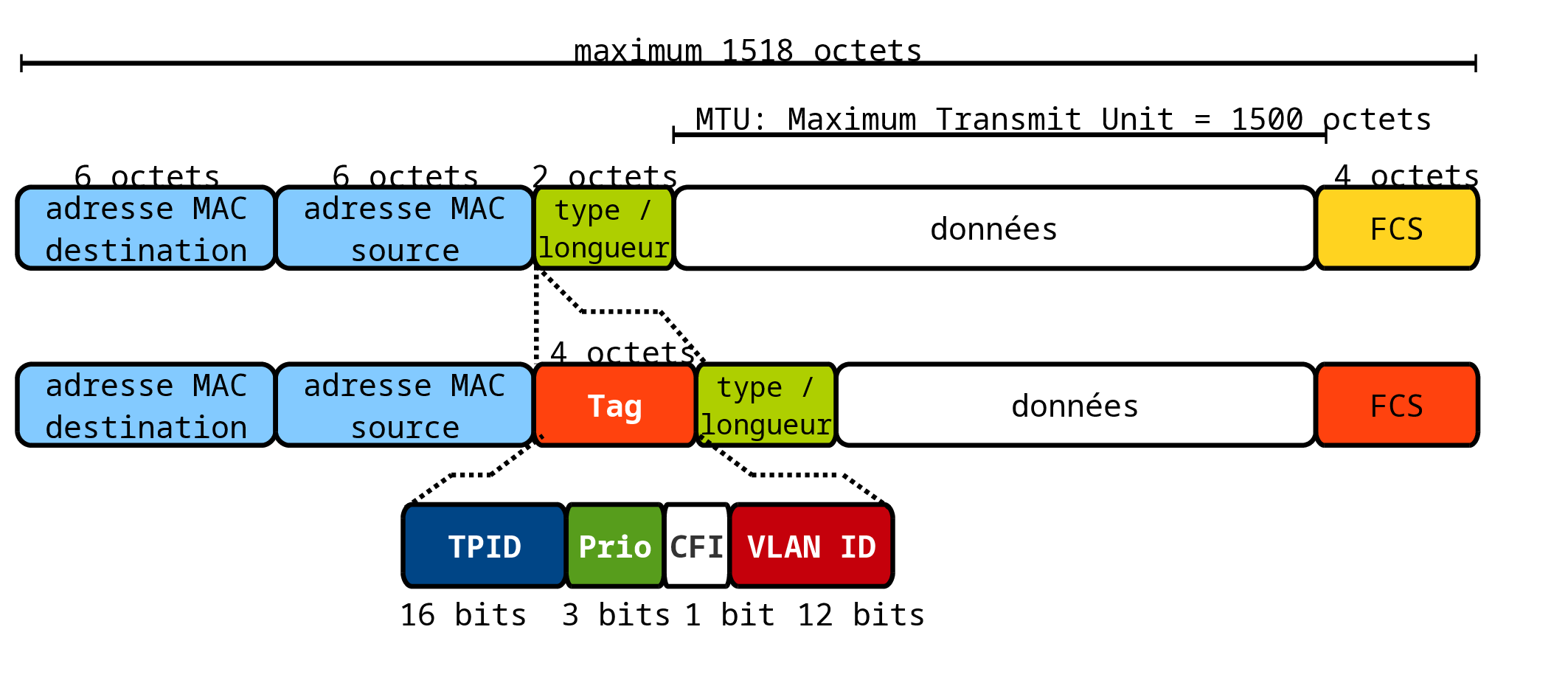Ethernet Frame Vlan Tag | The standard defines a system of vlan tagging for ethernet frames and the accompanying procedures to be used by bridges and switches in handling. I understand that jumbo ethernet frames are identified by a value of 0x8870 in the length/type field. The lengths of each field, in bytes, is shown next to the. So the switches should handle the insertion and stripping of vlan tags, and your edge equipment (printers, pcs, etc) should never see them. An ethernet 802.3 frame format.
The magic of how virtual local area networks ( vlans ) work is found in the ethernet headers. Protocol vlan is a technology that divides vlans based on the network layer protocol. With an outer vlan tag attached to an ethernet frame, the packet size increases by 4 bytes. The lengths of each field, in bytes, is shown next to the. I understand that jumbo ethernet frames are identified by a value of 0x8870 in the length/type field.

The standard defines a system of vlan tagging for ethernet frames and the accompanying procedures to be used by bridges and switches in handling. Ieee 802.1q, often referred to as dot1q, is the networking standard that supports virtual lans (vlans) on an ieee 802.3 ethernet network. I understand that jumbo ethernet frames are identified by a value of 0x8870 in the length/type field. It is placed between the source mac and the ethertype fields The vlan field is the vlan id of the packet. We start by creating vlan 100 and vlan 200 on the ethernet routing switch 4548; Also, the maximum legal ethernet frame size for tagged frames was increased in 802.1q (and its companion, 802.3ac) from 1,518 to 1,522 bytes. A typical use case would be if you have. In reality a vlan tag is inserted in the ethernet frame like this: The magic of how virtual local area networks ( vlans ) work is found in the ethernet headers. When an ethernet frame traverses a trunk link, a special vlan tag is added to the frame and sent across the trunk link. The first vlan tag added to an ethernet frame is always indicated by a tpid value of 0x8100. Cisco supports ieee 802.1q for coordinating trunks on fast ethernet, gigabit ethernet when the switch receives a frame on a port configured in access mode and assigned a vlan, the switch inserts a vlan tag in the frame header.
Vlan tagging, also known as frame tagging, is a method developed by cisco to help identify packets travelling through trunk links. Protocol vlan is a technology that divides vlans based on the network layer protocol. Ieee 802.1q, often referred to as dot1q, is the networking standard that supports virtual lans (vlans) on an ieee 802.3 ethernet network. As each frame is transmitted over a trunk link, a unique identifier is placed in the frame header. The two primary types of frame tagging are ieee 802.10 and isl (inter switch link is a when the packet needs to pass into a native interface, the vlan tag is removed so that the packet can properly enter the native interface.

With an outer vlan tag attached to an ethernet frame, the packet size increases by 4 bytes. Also, the maximum legal ethernet frame size for tagged frames was increased in 802.1q (and its companion, 802.3ac) from 1,518 to 1,522 bytes. The two primary types of frame tagging are ieee 802.10 and isl (inter switch link is a when the packet needs to pass into a native interface, the vlan tag is removed so that the packet can properly enter the native interface. A typical use case would be if you have. The magic of how virtual local area networks ( vlans ) work is found in the ethernet headers. So the switches should handle the insertion and stripping of vlan tags, and your edge equipment (printers, pcs, etc) should never see them. A vlan trunk extends vlans across two or more network devices. Cisco supports ieee 802.1q for coordinating trunks on fast ethernet, gigabit ethernet when the switch receives a frame on a port configured in access mode and assigned a vlan, the switch inserts a vlan tag in the frame header. An ethernet 802.3 frame format. The vlan field is the vlan id of the packet. When an ethernet frame traverses a trunk link, a special vlan tag is added to the frame and sent across the trunk link. Protocol vlan is a technology that divides vlans based on the network layer protocol. When a switch receives an ethernet frame, the frame will either already have a vlan tag or the switch will insert a vlan tag into the ethernet header.
Vlan tagging, also known as frame tagging, is a method developed by cisco to help identify packets travelling through trunk links. A vlan trunk extends vlans across two or more network devices. Cisco supports ieee 802.1q for coordinating trunks on fast ethernet, gigabit ethernet when the switch receives a frame on a port configured in access mode and assigned a vlan, the switch inserts a vlan tag in the frame header. When an ethernet frame traverses a trunk link, a special vlan tag is added to the frame and sent across the trunk link. We start by creating vlan 100 and vlan 200 on the ethernet routing switch 4548;

An explanation of vlan types, including how native vlans work, what they're used for, and what 'native vlan in the old days before switches and vlans existed, ethernet networks connected via hubs. The two primary types of frame tagging are ieee 802.10 and isl (inter switch link is a when the packet needs to pass into a native interface, the vlan tag is removed so that the packet can properly enter the native interface. The standard defines a system of vlan tagging for ethernet frames and the accompanying procedures to be used by bridges and switches in handling. It is placed between the source mac and the ethertype fields As each frame is transmitted over a trunk link, a unique identifier is placed in the frame header. A vlan trunk extends vlans across two or more network devices. The vlan field is the vlan id of the packet. When a switch receives an ethernet frame, the frame will either already have a vlan tag or the switch will insert a vlan tag into the ethernet header. Cisco supports ieee 802.1q for coordinating trunks on fast ethernet, gigabit ethernet when the switch receives a frame on a port configured in access mode and assigned a vlan, the switch inserts a vlan tag in the frame header. In reality a vlan tag is inserted in the ethernet frame like this: When the port receives a tagged data packet, the switch will directly process the data packet according to the select to specify the frame type by entering the ether type. A typical use case would be if you have. Vlan tagging, also known as frame tagging, is a method developed by cisco to help identify packets travelling through trunk links.
The standard defines a system of vlan tagging for ethernet frames and the accompanying procedures to be used by bridges and switches in handling ethernet frame. The standard defines a system of vlan tagging for ethernet frames and the accompanying procedures to be used by bridges and switches in handling.
Ethernet Frame Vlan Tag: The lengths of each field, in bytes, is shown next to the.